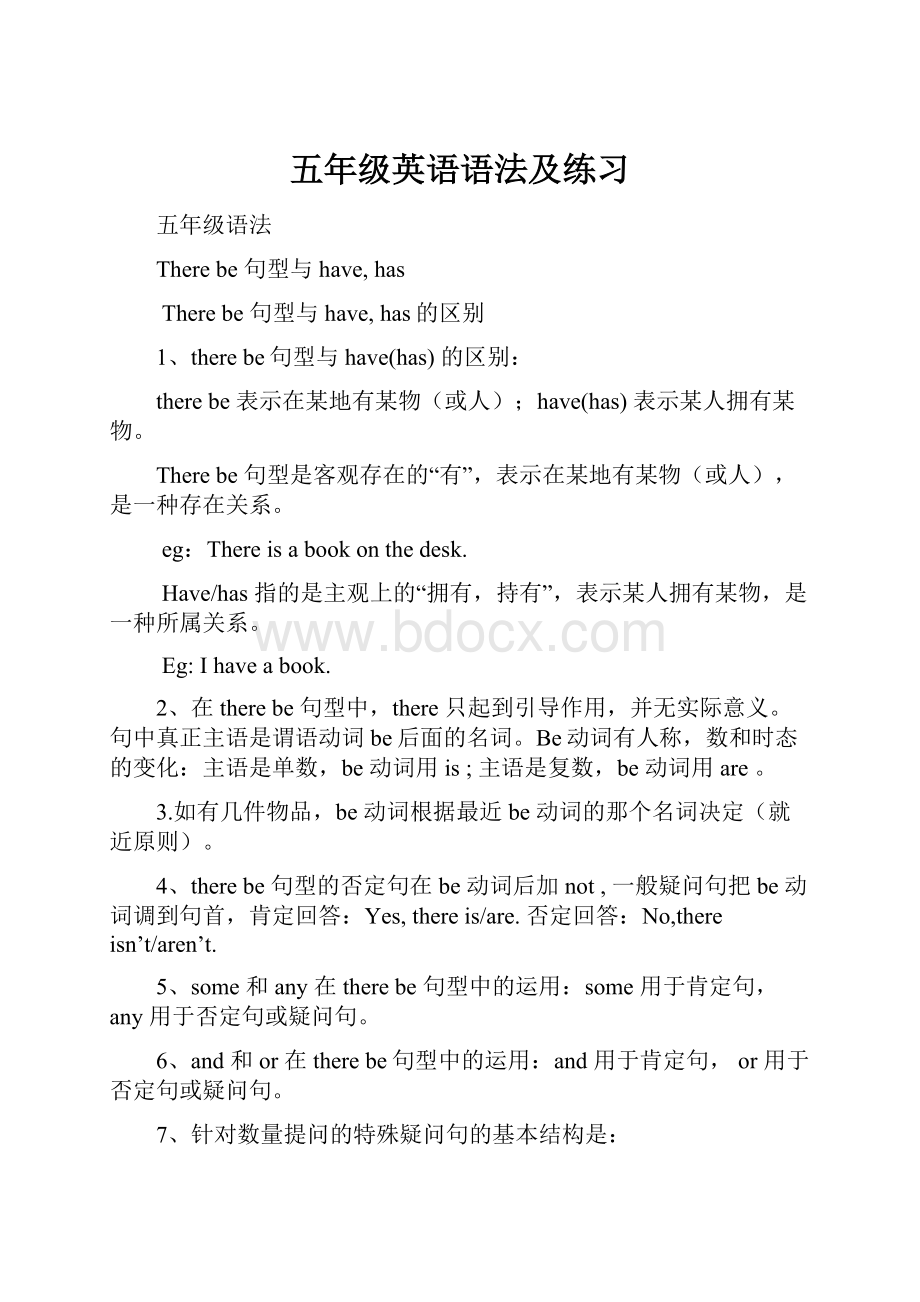五年级英语语法及练习.docx
《五年级英语语法及练习.docx》由会员分享,可在线阅读,更多相关《五年级英语语法及练习.docx(27页珍藏版)》请在冰豆网上搜索。

五年级英语语法及练习
五年级语法
Therebe句型与have,has
Therebe句型与have,has的区别
1、therebe句型与have(has)的区别:
therebe表示在某地有某物(或人);have(has)表示某人拥有某物。
Therebe句型是客观存在的“有”,表示在某地有某物(或人),是一种存在关系。
eg:
Thereisabookonthedesk.
Have/has指的是主观上的“拥有,持有”,表示某人拥有某物,是一种所属关系。
Eg:
Ihaveabook.
2、在therebe句型中,there只起到引导作用,并无实际意义。
句中真正主语是谓语动词be后面的名词。
Be动词有人称,数和时态的变化:
主语是单数,be动词用is;主语是复数,be动词用are。
3.如有几件物品,be动词根据最近be动词的那个名词决定(就近原则)。
4、therebe句型的否定句在be动词后加not,一般疑问句把be动词调到句首,肯定回答:
Yes,thereis/are.否定回答:
No,thereisn’t/aren’t.
5、some和any在therebe句型中的运用:
some用于肯定句,any用于否定句或疑问句。
6、and和or在therebe句型中的运用:
and用于肯定句,or用于否定句或疑问句。
7、针对数量提问的特殊疑问句的基本结构是:
Howmany+名词复数+arethere+介词短语?
Howmuch+不可数名词+isthere+介词短语?
8、针对主语提问的特殊疑问句的基本结构是:
What’s+介词短语?
练习:
Fillintheblankwith“have,has”or“thereis,thereare”
1.I________agoodfatherandagoodmother.
2.____________atelephoneonthedesk.
3.He_________atape-recorder.
4._____________abasketballintheplayground.
5.She__________somedresses.
6.They___________anicegarden.
7.Whatdoyou___________?
8.______________areading-roominthebuilding?
9.WhatdoesMike___________?
10.______________anybooksinthebookcase?
11.Myfather_________astory-book.
12._______________astory-bookonthetable.
13._______________anyflowersinthevase?
14.Howmanystudents____________intheclassroom?
15.Myparents___________somenicepictures.
16._____________somesouponthetable.
17.______________amapoftheworldonthewall.
18.David__________atelescope.
19.David’sfriends___________sometents.
20.______________manychildrenonthehill.
Fillintheblankwith“have,has”
1.I_________anicepuppet.
2.He_________agoodfriend.
3.They__________somemasks.
4.We___________someflowers.
5.She___________aduck.
6.Myfather____________anewbike.
7.Hermother___________avase.
8.Ourteacher_________anEnglishbook.
9.Ourteachers___________abasketball.
10.Theirparents___________someblankets
11.Nancy_________manyskirts.
12.David__________somejackets.
13.Myfriends__________afootball.
14.Whatdoyou__________?
15.WhatdoesMike__________?
16.Whatdoyourfriends___________?
17.WhatdoesHelen___________?
18.Hisbrother________abasketball.
19.Hersister_________anicedoll.
20.MissLi__________anEnglishbook.
改为否定句:
Thereissomemilkinthebottle.
_______________________________________________________________________________
填be动词。
There_____abookandtwopensonthedesk.
There_____twopensandabookonthedesk.
Be动词
Be动词是动词的一种,其中“am,is,are”用于一般现在时。
Be动词在句中不能单独作谓语,多与后面的名词或形容词等构成系表结构。
Be动词的使用口诀:
我用am,你用are,is跟着他她它。
单数is,复数are。
用be动词填空。
1.Thisbed_____toosoft.
2.Where_____thecakes?
3.There______threebedsandachairintheroom.
4.There______abookandapenonthechair.
5.MysisterandI_______inthesameclass.
6.Twoandfive_____seven.
7.There______alotofsheeponthefarm.
8.Who_____singingintheroom?
Liuhuais.
9.There_____somewaterinthebottle.
10.Hecan_____ateacher.
语法及练习4一般现在时
一般现在时基本用法介绍
一般现在时的概念
表示经常、反复发生的动作或现在存在的状态。
一般现在时的标志词:
频率副词:
Always,usually,often,sometimes,
时间状语:
Every…
一般现在时的构成
1.be动词:
主语+be(am,is,are)+其它。
如:
Iamaboy.我是一个男孩。
2.行为动词:
主语+行为动词(+其它)。
如:
WestudyEnglish.我们学习英语。
当主语为第三人称单数(he,she,it)时,要在动词后加"-s"或"-es"。
如:
MarylikesChinese.玛丽喜欢汉语。
一般现在时的变化
1.否定句:
有be动词,be动词后+not
有情态动词,情态动词后+not
有动词,借助动词do/does后+not
2.一般疑问句:
有be动词,be动词提前
有情态动词,情态动词提前
有动词,借助动词do/does提前
3.特殊疑问句:
特殊疑问词+一般疑问句
一般现在时用法专练:
一、用括号内动词的适当形式填空。
1.Heoften________(have)dinnerathome.
2.DanielandTommy_______(be)inClassOne.
3.We_______(notwatch)TVonMonday.
4.Nick_______(notgo)tothezooonSunday.
5.______they________(like)theWorldCup?
6.What_______theyoften_______(do)onSaturdays?
7._______yourparents_______(read)newspaperseveryday?
8.Thegirl_______(teach)usEnglishonSundays.
9.SheandI________(take)awalktogethereveryevening.
10.There________(be)somewaterinthebottle.
11.Mike_______(like)cooking.
12.They_______(have)thesamehobby.
13.Myaunt_______(look)afterherbabycarefully.
14.Youalways_______(do)yourhomeworkwell.
15.I_______(be)ill.I’mstayinginbed.
16.She_______(go)toschoolfromMondaytoFriday.
17.LiuTao_______(do)notlikePE.
18.Thechildoften_______(watch)TVintheevening.
19.SuHaiandSuYang_______(have)eightlessonsthisterm.
20.-Whatday_______(be)ittoday?
-It’sSaturday.
二、按照要求改写句子。
1.DanielwatchesTVeveryevening.(改为否定句)__________________________________________________________________
2.Idomyhomeworkeveryday.(改为一般疑问句,作否定回答)__________________________________________________________________
3.Shelikesmilk.(改为一般疑问句,作肯定回答)
__________________________________________________________________
4.Amylikesplayingcomputergames.(改为一般疑问句,作否定回答)__________________________________________________________________
5.Wegotoschooleverymorning.(改为否定句)_________________________________________________________________
6.HespeaksEnglishverywell.(改为否定句)__________________________________________________________________
7.Iliketakingphotosinthepark.(对划线部分提问)__________________________________________________________________
8.JohncomesfromCanada.(对划线部分提问)__________________________________________________________________
9.Sheisalwaysagoodstudent.(改为一般疑问句,作否定回答)__________________________________________________________________
10.SimonandDaniellikegoingskating.(改为否定句)__________________________________________________________________
三、改错(划出错误的地方,将正确的写在横线上)
1.IsyourbrotherspeakEnglish?
________________________________
2.Doeshelikesgoingfishing?
__________________________________
3.Helikesplaygamesafterclass.______________________________
4.Mr.WuteachsusEnglish._____________________________________
5.Shedon’tdoherhomeworkonSundays.________________________
动词三单的变化规则
1.一般情况下,直接加-s,如:
cook-cooks,milk-milks
2.以s.x.sh.ch.o结尾,加-es,如:
guess-guesses,wash-washes,watch-watches,go-goes
3.以“辅音字母+y”结尾,变y为i,再加-es,如:
study-studies
练习:
写出下列动词的第三人称单数
drink________go_______stay________make________
look_________have_______pass_______carry________
come________watch______plant_______fly_________
study_______brush________do_________teach_______
wash_______
二、用括号内动词的适当形式填空。
1.Heoften________(have)dinnerathome.
2.DanielandTommy_______(be)inClassOne.
3.We_______(notwatch)TVonMonday.
4.Nick_______(notgo)tothezooonSunday.
5.______they________(like)theWorldCup?
6.What_______theyoften_______(do)onSaturdays?
7._______yourparents_______(read)newspaperseveryday?
8.Thegirl_______(teach)usEnglishonSundays.
9.SheandI________(take)awalktogethereveryevening.
10.There________(be)somewaterinthebottle.
11.Mike_______(like)cooking.
12.They_______(have)thesamehobby.
13.Myaunt_______(look)afterherbabycarefully.
14.Youalways_______(do)yourhomeworkwell.
15.I_______(be)ill.I
’mstayinginbed.
16.She_______(go)toschoolfromMondaytoFriday.
17.LiuTao_______(do)notlikePE.
18.Thechildoften_______(watch)TVintheevening.
19.SuHaiandSuYang_______(have)eightlessonsthisterm.
20.-Whatday_______(be)ittoday?
-It’sSaturday
第三人称单数主语
1.人称代词he,she,it
2.单个人名,地名或称呼
3.单数可数名词或“this、that+可数名词单数”
4.不定代词someone,somebody,nobody,everything,something及指示代词this,that
名词
一.名词分类。
名词分为可数名词和不可数名词。
可数名词有单数和复数之分。
二.可数名词复数规则
1.一般情况下,直接加-s,如:
book-books,bag-bags,cat-cats,bed-beds
2.以s.x.sh.Ch和部分O结尾,加-es,如:
bus-buses,box-boxes,watch-watches
Photo-photos,
3.以“辅音字母+y”结尾,变y为i,再加-es,如:
family-families,strawberry-strawberries
4.以“f或fe”结尾,变f或fe为v,再加-es,如:
knife-knives
5.单复同型:
fish-fish,deer-deer,sheep-sheep,people-people,Chinese-Chinese,Japanese-Japanese
6.不规则名词复数:
改变中间的原因字母:
man-men,woman-women,policeman-policemen,policewoman-policewomen,foot-feet,tooth-teeth
词尾加-en或-ren:
child-children,ox-oxen
不规则:
mouse-mice
三.不可数名词
不可数名词主要是物质名词和抽象名词。
不可数名词没有复数形式,也不能与a,an连用。
四.不可数名词量的表示方法
1.用some,much,alittle,alotof,lotsof等表示多少。
2.用量词表示:
在表示“一”个数量概念时用acupof,abottleof,aglassof等,若要表达两个或两个以上得概念,量词用复数,不可数不变,eg:
twocupsoftea
练习:
写出下列各词的复数。
I_________ him_________this_______her______ watch_______book_______bus______Chinese________acupoftea_______house_______child_______
photo________diary______ day________ foot________dress________tooth______sheep______box_______ strawberry__________thief_______yo-yo______peach______sandwich______man______ woman_______paper_______people________
单选。
1.Hedoesmany_____.
A.workB.jobC.worksD.jobs
名词所有格
名词所有格一般是在名词后面加上’s,意为“。
。
。
的”,表示所属关系。
1.一般情况下,在单词词尾+’s
2.以s结尾的复数名词,在词尾+‘
3.不以s结尾的不规则复数名词,在词尾+’s
4.若表示两者各自拥有的东西,在两个名词后面都+’s;若表示两者共同拥有一个东西,则只在后面的名词后+’s
5.一些表示日期,时间,距离,国家名称的无生命的名词,也可加’s
6.如果’s后面的词是商店,住宅等地点,后面的名词要省略。
感叹句
感叹句通常由what或how引导,用以表示赞美、惊叹、喜悦等感情,句末一般用感叹号。
一.感叹句句型:
1.What+a(an)+形容词+可数名词单数(+主语+动词+!
What+形容词+可数名词复数或可数名词(+主语+其他)!
Eg:
Whatabeautifulgirl(sheis)!
Whatbeautifulgirls(theyare)!
2.how+形容词/副词(+主语+动词)!
Howbeautiful(thegirlis)!
二.感叹句口诀:
陈改感叹并不难,what或how放最前;
形副紧跟how后,what要和名词连;
主语谓语在句末,它们省略也常见。
三.“一断,二加,三换位”法。
一断:
在谓语后面断开,使句子分为两部分。
Eg:
Heis/agoodteacher.
二加:
在第二部分前加上how或what。
Eg:
Heis/whatagoodteacher.
三换位:
把第一部分和第二部分位置互换,句号改成感叹号。
Eg:
Whatagoodteacherheis!
将下列句子改为感叹句。
1.Theshipisbig.
_______________________________________________________________________
2.Thisfilmisverygood.
_______________________________________________________________________
3.Heworksveryhard.
_______________________________________________________________________
4.Itisanicebook.
_______________